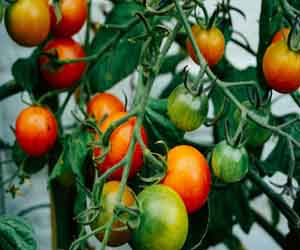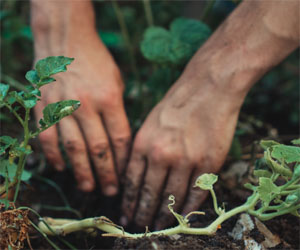


Cultivating Your Green Thumb

Gardening is a wonderful and rewarding hobby that allows you to connect with nature, beautify your surroundings, and even grow your own fresh produce. If you're new to gardening, the prospect may seem a bit daunting, but fear not - gardening is accessible to everyone, regardless of your experience level. In this article, we'll provide some essential tips to help beginners get started on their gardening journey.
Start Small: For beginners, it's often best to start with a small garden area. This can be a corner of your backyard, a few pots on your balcony, or even a sunny windowsill. Beginning with a small space allows you to learn the basics without feeling overwhelmed.
Choose The Right Location: select a location that receives adequate sunlight for the plants you want to grow. Most vegetables and flowers require at least 6 hours of direct sunlight per day. If you have limited sun exposure, consider shade-tolerant plants like hostas or ferns.
Select Easy-To-Grow Plants: As a beginner, it's wise to start with plants that are known for their resilience and forgiving nature. Some easy-to-grow choices include tomatoes, basil, marigolds, and zinnias. These plants are relatively low-maintenance and can be quite forgiving of minor mistakes.
Quality Soil Is Key: Healthy soil is the foundation of a successful garden. Invest in good-quality potting mix or amend your garden soil with organic matter like compost to improve its fertility and structure.
Learn About Watering: Overwatering and underwatering are common mistakes for beginners. Research the specific watering needs of your plants. Most plants prefer even, consistent moisture, but some drought-tolerant varieties may require less frequent watering.
Gardening Tools: Acquire a few essential gardening tools, including a trowel, hand pruners, a watering can or hose, and gardening gloves. These tools will make your gardening tasks much easier.
Garden Maintenance: Regular garden maintenance includes weeding, deadheading (removing spent flowers), and pruning. These tasks help keep your garden looking tidy and encourage healthy growth.
Understand Pests And Diseases: Learn to identify common garden pests and diseases. This knowledge will help you take early action to protect your plants. Consider using organic pest control methods to minimize chemical use.
Join Gardening Communities: Online forums, local gardening clubs, and community gardens can be valuable resources for beginners. You can learn from experienced gardeners, get advice, and even swap plants or seeds.
Patience And Learning: Gardening is a learning process, and even experienced gardeners encounter challenges. Be patient with yourself and your garden. Learn from your mistakes and successes, and don't be discouraged by setbacks.
Enjoy The Journey: Gardening is not just about the end result; it's also about the joy of nurturing and watching your plants thrive. Take the time to savor the beauty and tranquility of your green space.
Remember, every gardener starts as a beginner, and with time, you'll develop your green thumb and gain the confidence to tackle more complex gardening projects. Gardening is a hobby that can be a lifelong passion, providing you with countless opportunities to connect with nature and enjoy the fruits of your labor.
Maximize Your Space And Minimize Clutter
 2. Wall-Mounted Shelves And Storage
2. Wall-Mounted Shelves And Storage
Utilize vertical space by installing wall-mounted shelves and storage units. These not only provide additional storage but also free up floor space, making your room feel more open and less cluttered.
3. Under-Bed Storage
Your bed can be more than just a place to sleep. Consider using the space underneath for storage. Under-bed drawers or bins are excellent for storing clothing, shoes, and other items you don't use daily.
4. Compact Kitchen Appliances
In a small kitchen, compact appliances can save valuable counter and cabinet space. Look for smaller refrigerators, slim dishwashers, and mini appliances that fit your needs without dominating your kitchen.
5. Fold-Down Tables
Fold-down tables are perfect for small dining areas or home offices. They can be easily stowed away when not in use, creating more room for everyday activities.
6. Pegboards And Hooks
Pegboards and hooks can be a game-changer for organizing and storing items like kitchen utensils, tools, or office supplies. These space-saving solutions keep your essentials within arm's reach without cluttering up drawers or countertops.
7. Magnetic Strips
In the kitchen, magnetic strips mounted on the wall can hold knives and metal spice containers, saving counter and drawer space. They're not only functional but also add a unique design element to your kitchen.
Opportunities And Challenges For A Changing World
 The world's population has been steadily increasing for centuries, driven by a combination of factors, including increased life expectancy, reduced mortality rates, and, in some regions, high fertility rates. While the global population growth rate has been slowing down, it remains a significant concern due to its implications on resources, infrastructure, and quality of life.
The world's population has been steadily increasing for centuries, driven by a combination of factors, including increased life expectancy, reduced mortality rates, and, in some regions, high fertility rates. While the global population growth rate has been slowing down, it remains a significant concern due to its implications on resources, infrastructure, and quality of life.
One of the challenges associated with rapid population growth is the strain it places on resources. As the number of people on the planet increases, so does the demand for essentials like food, water, energy, and housing. This growing demand can lead to resource scarcity, environmental degradation, and increased competition for limited resources.
Moreover, population growth often has economic implications. While a growing population can contribute to a larger labor force, which can be a source of economic growth, it can also lead to unemployment and underemployment if job opportunities do not keep pace with the increase in the labor force. Balancing economic growth with the needs of a growing population is a delicate challenge for governments and policymakers.
Urbanization is closely linked to population growth. As more people move to cities in search of better opportunities, urban areas experience increased pressure on housing, transportation, and social services. Rapid and unplanned urbanization can lead to inadequate infrastructure, housing shortages, and increased pollution, posing health and environmental risks.
Building A Brighter Future Together
 Environmental Sustainability: At the heart of sustainable communities is a commitment to reducing their environmental footprint. This involves adopting eco-friendly construction and infrastructure, implementing energy-efficient technologies, reducing waste, and practicing sustainable land use.
Environmental Sustainability: At the heart of sustainable communities is a commitment to reducing their environmental footprint. This involves adopting eco-friendly construction and infrastructure, implementing energy-efficient technologies, reducing waste, and practicing sustainable land use.
Community Engagement: Sustainable communities prioritize community engagement and participation in decision-making processes. Residents actively contribute to the development and management of their community, fostering a sense of ownership and responsibility.
Social Equity: Social equity is a key component of sustainability. Sustainable communities aim to be inclusive and equitable, promoting equal access to resources, opportunities, and services for all residents, regardless of background or socioeconomic status.
Economic Resilience: Building economic resilience is crucial. Sustainable communities often emphasize local economies, supporting small businesses and initiatives that create jobs and enhance economic stability.
Eco-Friendly Transportation: Sustainable communities prioritize alternative transportation options such as cycling, walking, and public transit to reduce dependence on fossil fuels and lower carbon emissions.
Thriving In Compact Living
 1. Multifunctional Furniture
1. Multifunctional Furniture
One of the key principles of small space efficiency is multifunctional furniture. These pieces serve multiple purposes, allowing you to make the most of every square inch. Sofa beds, fold-out desks, and dining tables with hidden storage are excellent examples. They provide comfort and functionality without monopolizing valuable space.
2. Vertical Storage
Utilizing vertical space is a game-changer in small spaces. Wall-mounted shelves, cabinets, and hooks create storage opportunities while keeping the floor area open and uncluttered. Vertical storage can also lend a sense of height and depth to your small space, making it feel more expansive.
3. Clear Clutter Regularly
Living in a small space necessitates regular decluttering. Be selective about what you keep, and embrace the philosophy of "less is more." Donate or sell items you no longer need, and make a conscious effort to prevent new clutter from accumulating.
4. Dual-Purpose Rooms
In small homes, one room often serves multiple functions. For instance, your living room might double as a home office, or your bedroom may also function as a gym.
Keeping Your Garden Beautiful And Healthy
 Preventative Measures:
Preventative Measures:
The first step in effective weed management is prevention. Here are some strategies to consider:
Mulching: Apply a layer of organic mulch to your garden beds. Mulch not only conserves soil moisture and regulates temperature but also suppresses weed growth by blocking out sunlight.
Landscape Fabric: Landscape fabric or weed barrier cloth can be placed under mulch to provide an extra layer of weed control. It allows water to pass through while inhibiting weed growth.
Plant Density: Plant your garden densely to create competition for sunlight and nutrients, leaving less room for weeds to take hold.
Regular Inspection: Routinely inspect your garden for early signs of weeds. It's much easier to deal with a few weeds when they're small than to tackle a full-blown infestation.
Manual Weed Removal:
When weeds do appear, one of the most effective ways to manage them is through manual removal. Here's how to do it:
Use The Right Tools: Invest in a good set of hand tools for weeding, including a hand trowel, weeder, and a sharp hoe.
Get To The Roots: When weeding, it's crucial to remove the entire plant, including the roots. Weeds left with their roots intact can quickly grow back.
Weed After Rain Or Irrigation: It's easier to remove weeds when the soil is moist. Weeding shortly after rain or watering can make the task less labor-intensive.
Proper Disposal: After weeding, make sure to dispose of the pulled weeds properly. Don't leave them in your garden, as some weeds can regrow from detached pieces.